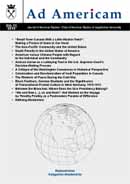The Asia-Pacific Community: Conditions, Feasibility and the Role of the U.S.
The Asia-Pacific Community: Conditions, Feasibility and the Role of the U.S.
Author(s): Marcin GrabowskiSubject(s): Economy
Published by: KSIĘGARNIA AKADEMICKA Sp. z o.o.
Summary/Abstract: This article discusses the Australian PM’s proposal of creating an Asia Pacific Community. It presents a theoretical basis for the integration within the Pacific Basin (including integrative potential of the region and gravity theory of trade) and the role of the Pacific Ocean as a certain stage for this organization. Four pillars of economic community (trade and investment, infrastructure, fi nancial and monetary cooperation, regional public goods) integration are also presented, as an economic community seems to be the only thing that could bring additional value to regional integration. Finally, it analyses the problem of conditions for the new institution, including problems of existing organizations of the region. As for the American role, there are three scenarios possible. In the first one, the U.S. would join the integration block, supporting the Asia-Pacific Community project by becoming a member. The second scenario supports the existing model of an East Asian integration, based on the East Asia Summit (EAS), where China’s influences are balanced by U.S. allies. The third possibility, seeming to be most likely, is to join the enlarged EAS, which seems to be possible, as the U.S. acceded to the Treaty of Amity and Cooperation (July 2009), which is a condition of joining the EAS.
Journal: Ad Americam. Journal of American Studies
- Issue Year: 2010
- Issue No: 11
- Page Range: 19-35
- Page Count: 17
- Language: English

